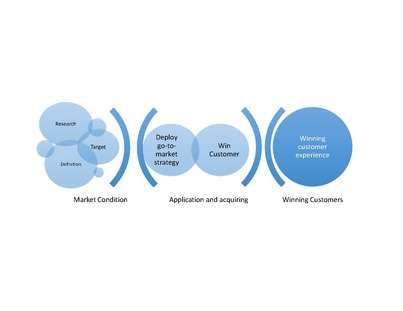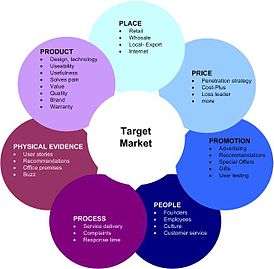Go to market
Go-to-market or go-to-market strategy is the plan of an organization, utilizing their inside and outside resources (e.g. sales force and distributors), to deliver their unique value proposition to customers and achieve competitive advantage.[1][2]
The end goal of a go-to-market strategy is to enhance the overall customer experience taking into account various aspects of the value proposition such as the quality of the product and pricing.[3]
Developing a go-to-market strategy

In the earliest stages of developing a go-to-market strategy for a new product or a service, the company has to initially conduct an accurate definition of the target market. The company has to decide whether they already have prospective customers within their customer base but using different services.[3]
After defining the market, the product or service is researched until a final decision has been made on what the value proposition will be. Then the company determines its pricing strategy. It is very challenging to decide what pricing strategy to follow as it differs from one product or service to another, or even when the product or service remains the same but the strategy changes, such as switching to subscription-based pricing (an example for this is Adobe's major shift from selling its Creative Suite software which included all Adobe's products such as Photoshop and Illustrator, to a $50-per-month Creative Cloud and various other subscription plans).[4]
Moreover, choosing the right distribution and marketing channels followed by promotion are very vital steps in a go-to-market strategy. A company has to decide which distribution model to choose, what kind of support and services are required and addressing the possibility of creating a competitive advantage.[5] Afterwards, the company decides how it is going to promote its product or services and what kind of marketing campaigns are the most influential to follow.[3]
Driving factors in a go-to-market strategy
When considering to develop a go-to-market strategy, there are 3 essential factors to focus on:[5]
Customers
Delivering exceptional customer experiences leads to loyalty and advocacy of the customer. Consequently, that triggers increase in product purchase, customer retention and low cost of service.[6]
Company
Taking company's mission and vision into account is a key determining factor when performing a go-to-market strategy. Motivating employees to perform well is a decisive factor to include. Thus, defining company's vision and what kind of impact it is trying to create is essential in the earliest stages of a go-to-market strategy.[7]
Competition
Understanding the competition is crucial in deciding what product or service to offer. Gathering information about how competitors are performing in the market, what customers think of the different products available and what is missing in the market through conducting research using different methods such as SWOT and PEST analyses.[8]
?? Market Segmentation in a mgo-to-market strategy == Market segmentation is the process by which one divides prospective customers into different groups (segments) that have common needs and the same expected reaction to a marketing action. This approach enables companies to offer customers full value proposition of their products or services.[9]

There are common factors considered when performing a market segmentation in a go-to-market strategy:[10]
- Industry: The industry in which the customer is involved.
- Customer size and sales potential of the customer.
- Customer behavior: Studying the customer's behavior related to the product or service such as the customer buying from a competitor or examining the responsiveness to selling effort.
- Geography: Geographical locations of prospective buyers.
- Application and use of the product or service by the customer.
- Benefits earned by the customer due to buying the product or service.
- Information which is required to be provided by the company to the customer.
- Usage situation: When and where the product or service is used.
- Profitability of selling to a certain customer.
Go-to-market strategy and marketing strategy
Marketing strategy includes every marketing activity which helps an organization to target the market after conducting market research.[11]
Go-to-market strategy usually develops during the introduction of new products or services. Marketing strategy covers:[12]
- the products or services of a business
- market share and position of those products and services
- identification of clients and competitors
- basics of a marketing plan
Example of a go-to-market strategy
An example of using a go-to-market strategy could be observed in the automobile insurance industry. Initially, the company has to choose the right segment of the market (market segmentation). If the customers are considered individual households, then the company works on creating interest to their prospective customers using different forms of media such as TV advertisements, social media and billboards. Once the customers are persuaded to proceed, they are offered to purchase for the service through different channels such as the internet (company's website) or agents, both of which act as entities responsible for customer service.
In case of customers being corporate accounts during the market segmentation process, interest creation and purchase are done through direct sales, agents or the internet. Tele-service and direct service representatives serve as contacts after the purchase is done.[10]
See also
References
- ↑ Friedman, Lawrence (2002). Go-To-Market Strategy. Oxford: Butterworth-Heinemann.
- ↑ Zoltners, Andris; Sinha, Prabha; Lorimer, Sally (2004). Sales Force Design For Strategic Advantage. New York: Palgrave Macmillan.
- 1 2 3 "What is go-to-market strategy (GTM strategy)? - Definition from WhatIs.com". SearchITChannel. Retrieved 2015-11-01.
- ↑ "Adobe kills Creative Suite, goes subscription-only - CNET". CNET. Retrieved 2015-11-01.
- 1 2 "AIPMM's What is a go-to-market strategy and how to create one". Retrieved November 1, 2015.
- ↑ "Creating an adaptive go-to-market system - Bain & Company". www.bain.com. Retrieved 2015-11-01.
- ↑ "Your Company’s Purpose Is Not Its Vision, Mission, or Values". Harvard Business Review. Retrieved 2015-11-01.
- ↑ Caan, James. "Knowing your market and competition is crucial when starting up". the Guardian. Retrieved 2015-11-01.
- ↑ "Market Segmentation Definition | Investopedia". Investopedia. Retrieved 2015-11-01.
- 1 2 Zoltners, Andirs; Sinha, Prabhakanat; Zoltners, Greggor (2001). The Complete Guide To Accelerating Sales Force Performance. New York: AMACOM.
- ↑ "What is marketing strategy? definition and meaning". BusinessDictionary.com. Retrieved 2015-11-02.
- ↑ "Develop a marketing strategy". www.business.qld.gov.au. Retrieved 2015-11-01.